Is Fuji’s AF the most advanced out there? Plus their coming 100-megapixel body. Fujifilm Q&A from CP+!
posted Friday, March 15, 2019 at 9:56 PM EDT

I had a chance to sit down with two top Fujifilm execs (Toshihisa Iida and Makoto Oishi) at the recent CP+ 2019 show in Yokohama, Japan, to ask them about everything from the state of the industry to my usual tech-geeky questions about underlying technology. I've been wanting to write about some of the details of Fujifilm's advanced autofocus tech ever since the X-T3 was announced, so got in some good discussion about that here. We also saw some very cool-looking lens mockups and discussed their coming 100-megapixel medium-format monster. Read on for all the details!
Dave Etchells/Imaging Resource: So one thing we're asking everybody is Mitarai-san from Canon is on record recently...
<crosstalk, laughter>
DE: You've been hearing that too? Yeah, and so he says that the interchangeable-lens business is going to contract by half, over the next two years. Do you agree with that assessment? What are your own projections?
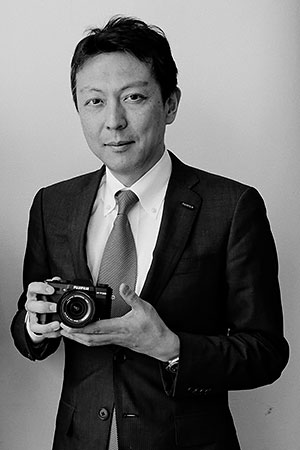
General Manager, Optical Device and Electronic Imaging Products Division
Fujifilm Corp.
Toshihisa Iida/Fujifilm: Totally, totally disagree.
DE: You totally disagree.
<laughter>
TI: We really just cannot believe that projection of Canon's.
DE: Yeah. What are your projections, what do you think the market will do overall?
TI: I think it all depends on what innovation and what influence comes from the manufacturers. It's our mission to make the market viable. So I think our projection is there's a lot of room even to grow further in the camera market.
DE: It might even grow? (!)
TI: Yeah, yeah, yeah. If we look at the Asian market, there's a huge population over there. Some countries may decline, but some countries soon will change to growth. I think overall, the global camera market, you know...
DE: ...is actually going to grow as well. Wow, that's interesting. Yeah, certainly I hear from everyone that China is a huge market, and it's got to be pretty low penetration for cameras there still, so there's a lot of opportunity there.
TI: Yes.
DE: OK, that's interesting. Moving on ... so everyone's focusing on full-frame cameras, you know...
TI: <chuckles>
DE: ...Canon, Nikon, Panasonic with their latest announcements, of course. And Sony's been there for a long while. Do you think, with all of that focus on full-frame, that there's an opportunity for Fujifilm to capture more crop-frame market share?
TI: Yes, yes. I think the customers should have different options. We don't believe that all of the customers will go to full-frame. At the moment, I think the proportion of full-frame is probably one-third of the market by value.
DE: Oh, by value actually. So in terms of unit sales, it would be much lower.
TI: Yes, so two-thirds of the market is non-full frame, which is predominantly APS-C, Micro Four Thirds, and some medium-format as well.
DE: Mmm-hmm...
TI: The customers do need options. So I think instead of just joining that full-frame competition, we will focus more on APS-C and we will focus on medium-format. I think for us, other competitors that are focusing on full-frame will maybe open up the opportunity for us, as long as we keep innovating for APS-C and medium-format.
DE: Yeah, I think you have a good position; you're kind of bracketing full-frame. It's like on the one hand, if you want compact, then APS-C is better. But if you really want ultimate image quality, then medium-format makes more sense.
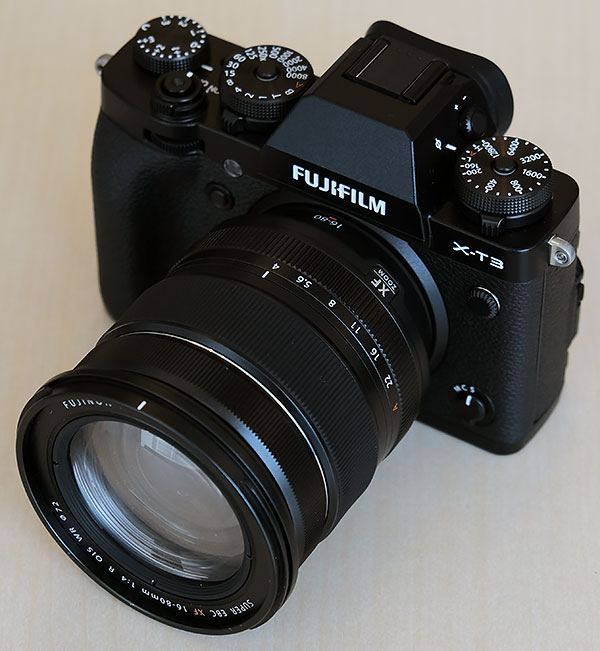
TI: Yeah, yeah. Yes, I think the Fuji X-T3, it's a good APS, you know. As long as we keep introducing good APS-C cameras that the market wants, customers are waiting for good APS-C models.
DE: That's a good business for you, yeah. Is Fujifilm's business total volume growing year-over-year currently, or just keeping level?
TI: Yes, we just closed a third quarter of this fiscal, which is October to this December, I think already it's gone up a little bit.
DE: Ah, that's encouraging.
TI: By 10%? Over 10%, I think.
DE: Wow, that's really good, because the overall market is declining some. The fact that you're growing is very positive.
TI: Yes. Yes, of course, that is hugely contributed to by the Fuji GFX 50R and X-T3.
DE: Yes. So you probably had optimistic projections for the X-T3, but how did the response end up, compared to your projections?
TI: More than we expected, I think. Yeah.
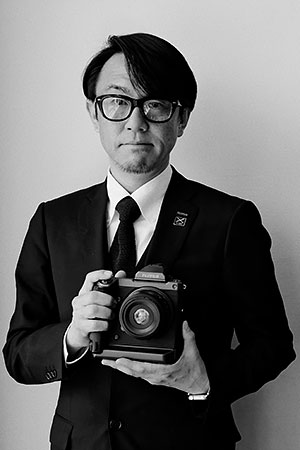
Manager of Sales & Marketing Division, Optical Device and Electronic Imaging Products Division
Fujifilm Corp.
Makoto Oishi/Fujifilm: Especially compared to, like, the Fuji X-T2. It's more.
DE: Much more than X-T2. Ah...
TI: Yeah, I think that that's...
MO: More than 40% better than...
DE: Wow, 40% better than X-T2? That's a huge increase!
TI: Yeah, if you compare to the same period since launch.
DE: Yeah. That's great. As I said earlier (before the official interview began), it's one of the most popular cameras on our site. There's been just constant interest.
William Brawley/Imaging Resource: Oh, yeah. Consistently!
DE: It's interesting too about people's perceptions and where full-frame fits. I was talking to a friend of my wife's the other day; she wanted to buy a camera and was wondering what model. She specifically mentioned that she wanted something compact, because she and her husband were planning to travel a fair bit, so I asked "Well, have you considered mirrorless?" And she said "Oh, mirrorless, that's full-frame, isn't it?" And that was interesting, because this was a random US consumer. When she thought mirrorless, she immediately thought full-frame. So I think there's a need for messaging on Fujifilm's part that emphasizes the aspect of compactness. And certainly, Olympus has very clearly identified that their niche is compact and high-quality. When I interviewed Aki-san from Olympus US back in October (we published it in January), it was encouraging to me that he was very clear about stating that there are different kinds of photography that they are focused on, like moving subjects outdoors. That was their territory and they had no reason to go elsewhere. I'm talking too much, but just wanted to reinforce that I think you have a good strategy. [Ed. Note: Yes, I did indeed talk too much again, no need to remind me! ;-) ]
TI: Thank you.
DE: So we just talked a bit around this area, but one of the questions I had explicitly was how do you avoid people viewing full-frame as a happy medium? It's like, APS-C is small, medium-format is big, but maybe full-frame is a nice balance? I wonder if that's a perception consumers might have, and that you need to convince them that, no, really, APS-C is fine?
TI: Yeah, I think normallly customers do understand, and can decide which system is the best fit into their expectation, or their style of photography. It's not just the sensor size, but also the lens size, lens weight, overall cost, or the speed, the 4K movies. I think all customers have different requirements, and they can decide which system is best fitted to their needs.
DE: Mmm.
TI: I think people don't judge the system just because of the sensor size. I think that they regard more the overall package.
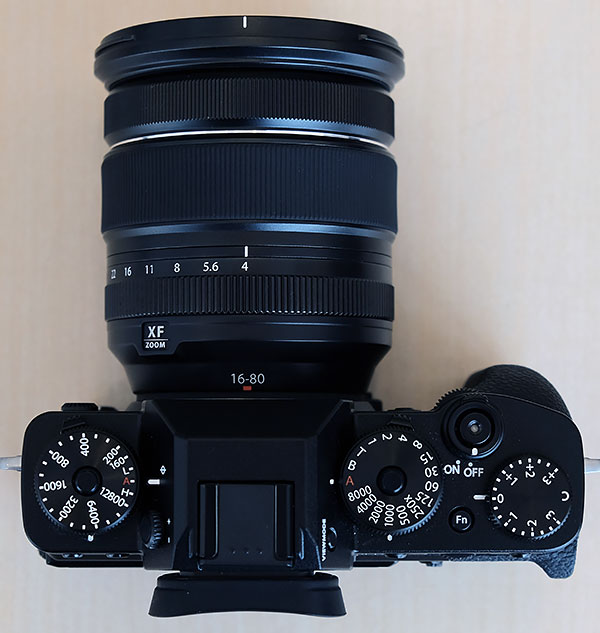
DE: Yeah, I was almost shocked when that was this woman's response, that "mirrorless equals full-frame". That's very strange to me.
We already talked about the X-T3, it seems like a big success. We think it's also surprisingly affordable, because the price-point is US$200 less than X-T2 was when it was announced. Was that strategic, a specific price-point that you were designing to?
TI: Yes.
DE: And we discussed this previously, maybe at Photokina I think, and I somewhat know the answer, but... The X-T3 seems an unusual position within your line, because you have the Fuji X-H1 that is technically a flagship, but the X-T3 actually has more advanced capabilities in many ways. Was there any discussion inside Fujifilm that the X-T3 would steal sales from X-H1, or any concern about that?
TI: Realistically, yeah, I think they've cannibalized each other a little bit. But we made a commercial decision to reposition the X-H1 in terms of the price-point. So now I think X-T3 and X-H1, they're sitting next to each other quite nicely. Because as you mentioned, when we introduced the X-T3 at the strategic price-point, I think in terms of pricing, it was a little bit confusing between X-H1 and X-T3. We adjusted the price positioning so that it's now clear.
DE: Ah, yeah - it would make sense if they're on par, because it's like you get some advanced features over here, or you get in-body stabilization over there, but it's at a similar price.
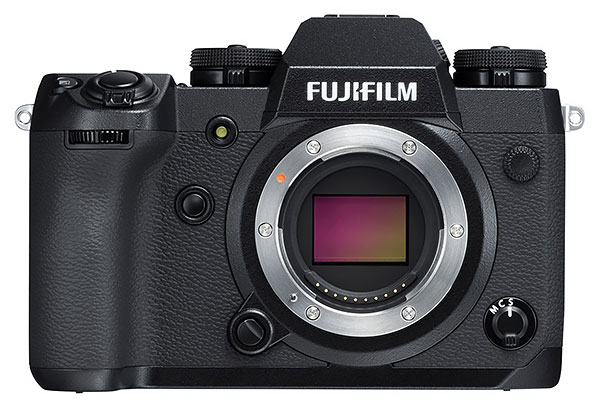
TI: Yes, yes. The type of photography is different for each, yes.
DE: And will there be an X-H series continuing that has stabilization, and will IS be the separating factor between the X-T and the X-H?
TI: It's not just with or without IBIS system. I think the style is also different for the big zooms and the big glass, versus the focus on compactness. So I think that both the H-series and T-series will coexist for the future.
DE: And then at some point, the X-H will catch up with features of the X-T, with some of the video capability, etc.
TI: Yeah we need to clearly differentiate the lineup without confusing customers.
DE: Mmm. And I think you kind of answered this question already, that the X-H1 introduced a lot of new features, particularly in terms of the camera design and ergonomics. Was there any consideration about putting some of those features, like a top LCD, or a deeper, DSLR-style front grip on the X-T3, or it sounds like you were really deliberately making the X-T3 as compact as possible?
TI: I think the X-T3 has that kind of DNA. Since we introduced the X-T1, as you mentioned, people love the [explicit] control of shutter speed and the mode dial and that compactness for, I think, an all-rounder sort of camera, but also particularly for being easy to carry. Lightweight and compactness is a very essential part of the X-T series. So we'd like to keep this concept for X-T series. But X-H is slightly different.
DE: Yeah, yeah. I mean, I love the X-T3. The design and the controls, it just feels really well-balanced in terms of how the user interface works.
TI: Yes. Thank you.
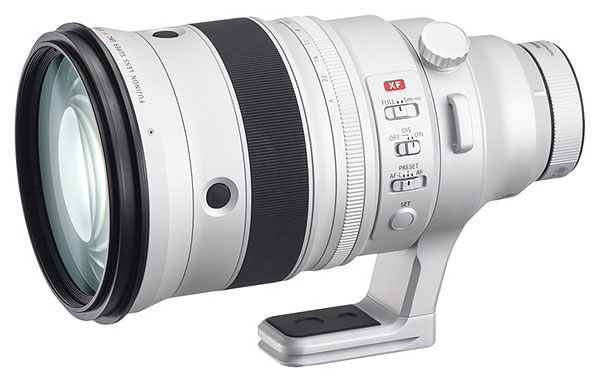
DE: Switching to lenses, last year you released the XF200mmF2, which is like a 300mm f/2 in terms of coverage.
TI: Yes.
DE: Does that signal an interest for Fujifilm to capture more of the sports market? And do you think there are other opportunities for you with that category of lens?
TI: That lens is not just designed for sports, but also for example for beautiful portraits. The wide-aperture telephoto lens, we don't limit it by saying it is for specific types of photography.
DE: Ah, yes, you don't say just sports, yeah. Do you think there's more opportunity in that area, the longer focal-length, large-aperture lenses? Is there demand for, like, an f/2.0 or very fast 100mm or 135mm too, or...
TI: I think that's similar to our XF90mmF2.
DE: Ah, yes, you have a 90mm that's f/2, so that kind of covers that particular range, yeah.
TI: That's a popular lens for portraiture as well.
DE: Yeah, 300mm equivalent is quite long for portrait, you have to stand off so far...
TI: Yeah, but very creamy bokeh.
DE: You get very creamy, beautiful bokeh, yes.
TI: Some professionals shoot things like concerts, or...
WB: Oh, right.
DE: Ohhh, shooting from a concert or something, not just a classic studio portrait or something...
TI: Yeah.
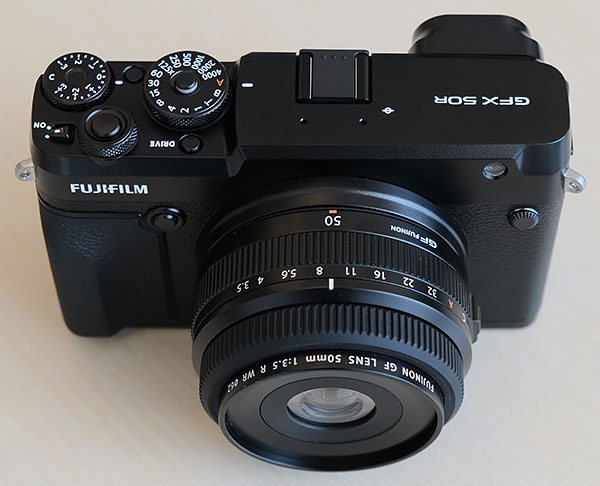
DE: Good point. And so, speaking of sports, the 2020 Olympics is on everybody's minds now. Olympus already announced the development of their 150-400mm super-tele zoom; it won't be available until 2020, but I think they want to have that in people's minds. Do you see the 2020 Olympics as an opportunity for Fujifilm to leverage its brand with sports photographers somehow?
TI: Yes, you know. I think we'd like to increase our awareness at the Summer Games. And the Summer Games are important not just for still photography, but also for movies. [Ed. Note: The International Olympic Committee is very strict about any company making any mention of the Olympic Games who isn't an official sponsor. Hence Fujifilm and others we spoke with have to use odd-sounding references, like "summer games", "international games", etc, when speaking of them. It's the same story in the US, where non-advertisers must refer to the annual Superbowl game as "the big game", etc. Lawyers... ;-) ]
DE: Oh, yes...
TI: As you know, Fujinon is a major supplier for broadcasting and cinema businesses.
DE: Yeah, yeah.
TI: So, we have the possibility to provide service to the videographers and broadcasters.
DE: Ahh.
TI: So I think that overall, as an imaging company, we'd like to support photographers and videographers and broadcasters.
DE: Yeah, that's a good point. You really have a somewhat unique position with all of your broadcast and cine products, maybe there's an opportunity for kind of a halo effect to draw your still cameras into.
TI: Yes.
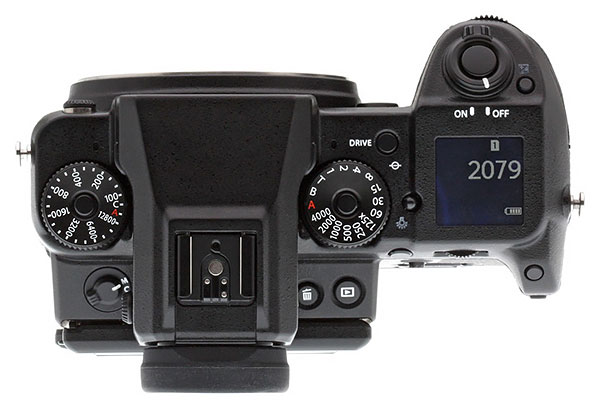
DE: I'm jumping around a lot in terms of products, but we're also curious about the GFX 50R.
TI: Mmm!
DE: It's easily the most affordable medium-format camera out there. How did sales there compare to your expectations, or what your projections were?
TI: Above our expectations. The factory is very busy. <chuckles>
DE: Hah, that's a good problem to have!
TI: Yeah.
DE: Where is that factory? Is that the Sendai factory, or is that...
TI: The Sendai factory, yes.
DE: Yeah, that must be very busy. You have a lot going on there right now. The Fuji GFX 50S was already very affordable, but do you think the additional decrease in price made a big difference?
TI: Yes.
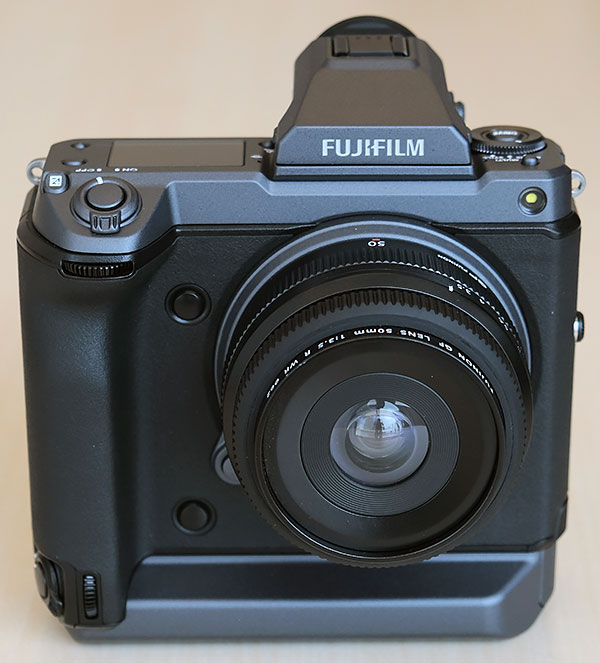
DE: And I know you can't talk about future products, but you've mentioned in the past the hundred-megapixel Fuji GFX 100. <shown a prototype camera> Oh, right here!
<laughter>
DE: So we do have one. And this is a functioning copy, not a woodblock? This is the actual camera, yeah?
TI: It's a very early prototype, but still working.
DE: <looking at the sensor> Boy, that's big. That is *really* big. It has a big grip on the bottom, also...
TI: In terms of hardware, the design is almost fixed.
MO: Yes. Firmware development is still going on.
WB: It's still very early firmware?
MO: Yeah. And the in-body image stabilization doesn't work yet.
WB: Ah, right.
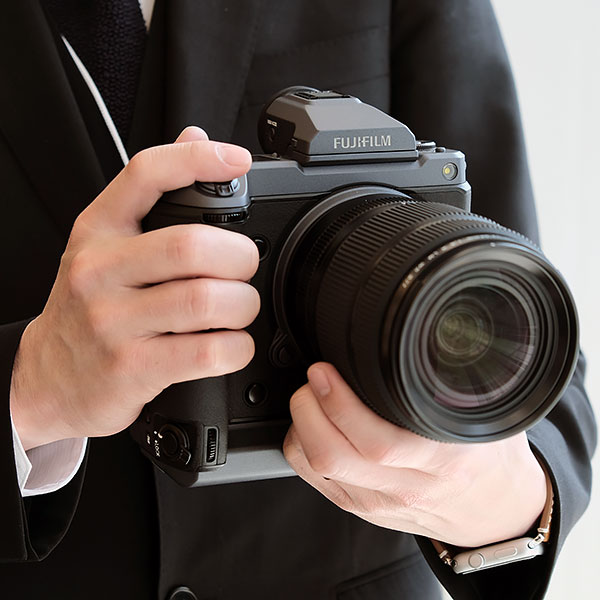
DE: Oh, that's right; this will have IBIS in it.
TI: It's a real [challenge], designing with the size, the weight...
WB: It's crazy that it has such a huge sensor in it, but it's more like a 1D-series kind of a profile.
DE: Had you showed this at Photokina as well, or is this the first time?
TI: Just a mockup there.
DE: Ah, so just a mockup there, but now it's functional. For the firmware development that is yet to be done, is that about interface and operation, or is it image quality that you're still working on?
TI: Image quality.
MO: Yes.
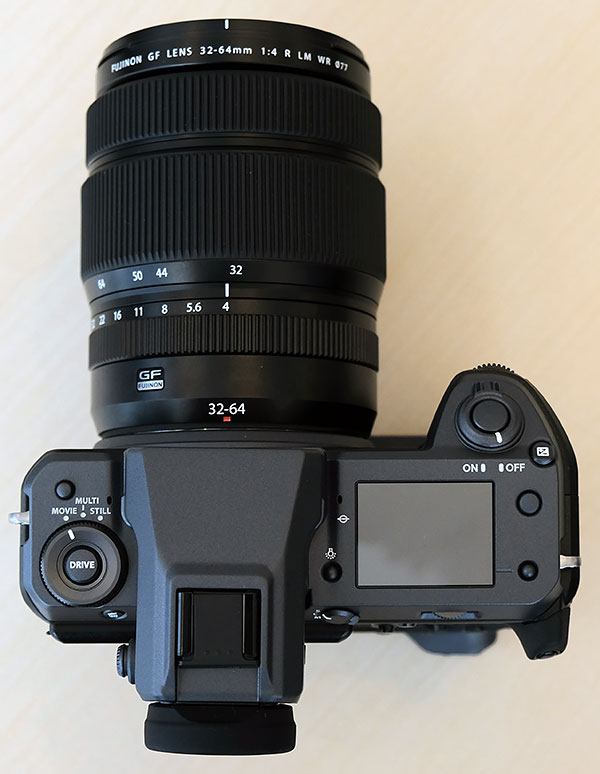
DE: Image quality, ah. So no chance for photos with this then, yet? ;-)
TI: Not yet.
DE: Well, with a working prototype, have you announced any schedule for the launch?
TI: We're just committed to before the end of June.
DE: Before the end of June? Oh, that's coming very soon then.
TI: In the first half of 2019.
DE: Oh, OK, that's great. [Ed. Note: So basically, no change since their previous announcement that it would be coming in the first half of 2019.] Yeah, I think you need to have a Tokyo event for the launch ;-) <chuckles> So this is very exciting. And have you said anything about what the price-point will be, or where it will fit price-wise?
TI: We haven't confirmed it yet, but we're targeting around US$10,000.
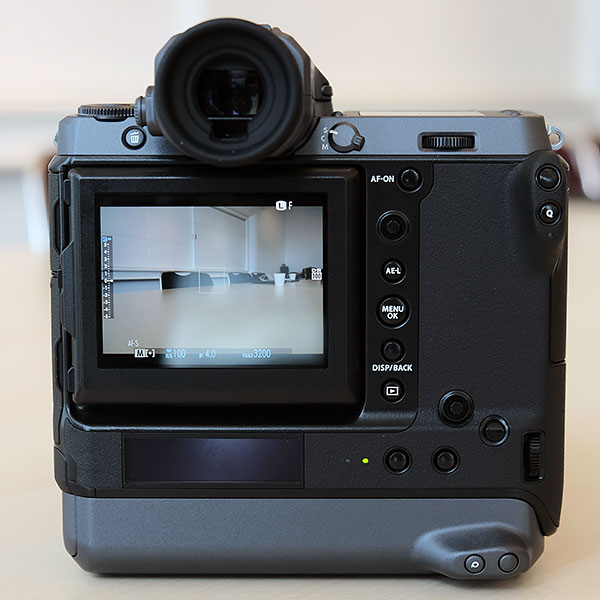
DE: That would give you a very nice range of prices then, within your line.
TI: I think so, yes.
DE: If this is going to be US$10,000, I bet it's going to be a very popular camera. I think I can predict you will sell more than you think, too.
MO: We sure hope so.
DE: Switching back to lenses agin, this is just a general question about GF lenses generally: Now that you've launched the GF100-200mmF5.6, you have a total of eight lenses in your line. Can you say anything about which lenses have the highest attach rate, and if the attach rates differ overall between the 50S and 50R?
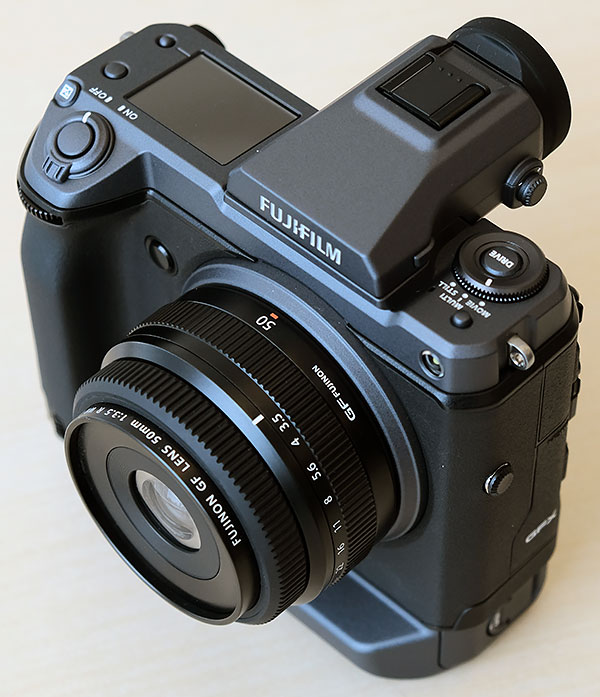
MO: Yes. In the case of the 50S, the GF32-64mmF4 zoom lens is quite popular, but when we introduced the 50R, it was popular with the GF45mmF2.8.
TI: The 45mm is smaller.
DE: And so you see more people going for the smaller, fixed focal length.
TI: Yes, and the focal length is equivalent to 35mm.
MO: More street photographers are interested in the 50R.
DE: Yea, it's a much better size for street photos, and not so large overall.
TI: That is the same focal length as the X100-series; 35mm.
DE: Do the S owners typically have more lenses than the R, or similar numbers?
TI: Yes, yes.

DE: It kind of makes sense, since they probably had higher budgets to begin with. So your current roadmap has only one more lens coming in 2019, the GF50mmF3.5...
MO: This mockup. <showing a mockup of the 50mm f/3.5> That goes really nicely on the 50R body. And then in 2020, you say you have a GF45-100mmF4 coming.
MO: Yes, yes. <showing another lens mockup> This is also a mockup.
DE: GFX users have lamented the lack of fast lenses, especially at the wide end. Is that a kind of optic you considered adding to the roadmap, something wide and fast?
TI: Yeah, we have gotten the same feedback. We are taking that into consideration for the future.
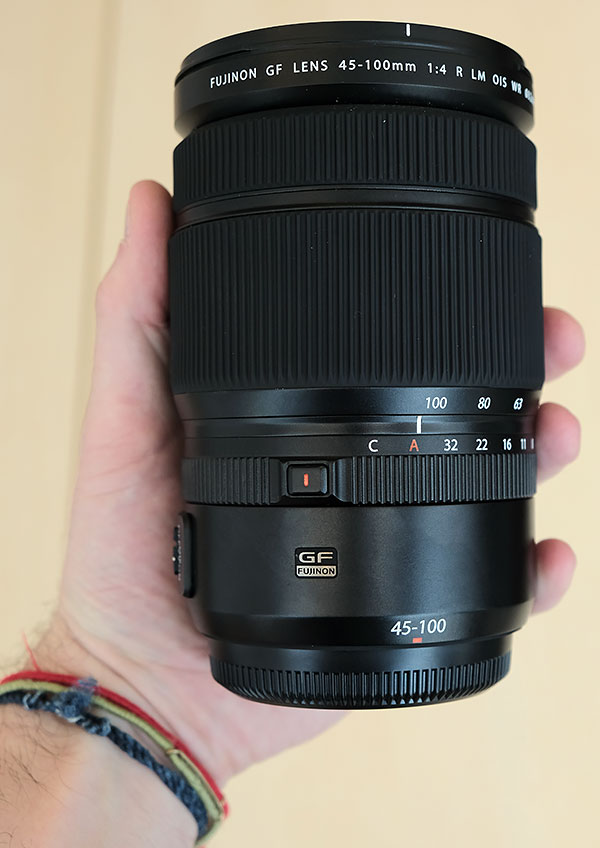
DE: How much of a role does user feedback play in planning what lenses that you're going to release?
TI: We keep getting feedback of what the customers expect, and we keep discussing it internally with the design team, yes. Sometimes when the customer says "I want this focal length and this aperture", they do it without knowing what the reality [would be], because the size and the cost...
MO: The size, the weight and the price...
DE: Oh, right, I'm sure...
TI: So it's not just about getting feedback about the numbers, we need to make that into a reality. That is the very difficult or challenging part, but we keep listening to the customers, and then trying to make it happen. As bright as possible, as small as possible, as affordable as possible...
DE: Yeah, you have to balance against what the reality would be. Of course someone will say, "Oh, I want a 100mm f/1.1" or something, and...
TI: Yeah, and this small <gestures>, and...
<laughter>
WB: ...and I want it for US$200, please!
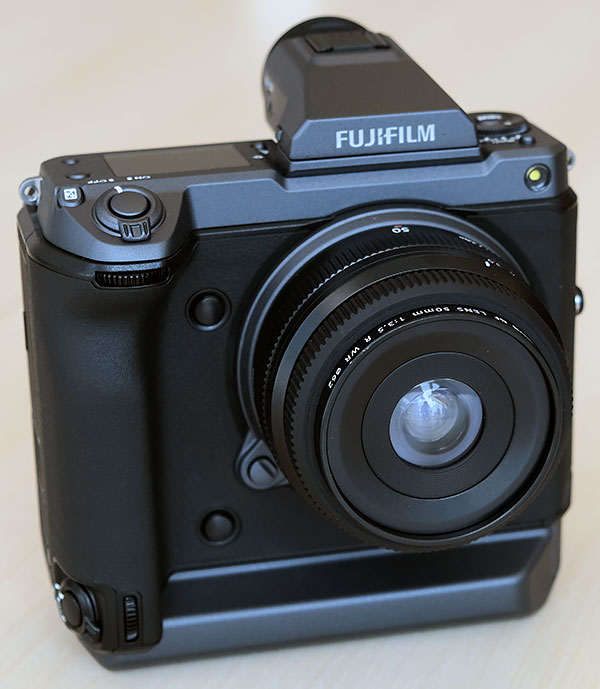
DE: Haha, right? So moving along, this is also a question about the GF, although I'll start out talking about the X-T3, which was a big step up in AF technology for you, I think.
TI: Yes.
DE: It was much more sophisticated, both at the level of the circuitry in the processor and in the back-end processing.
TI: Yes.
DE: Can we expect to see that kind of AF technology in the GF line soon?
TI: Yes, the next GFX 100-megapixel has got basically the same sensor structure as the X-T3.
DE: Ah!
TI: It is a copper-process, backside-illuminated sensor. [Ed. Note: Meaning that it uses copper wiring, which makes for higher readout speeds and lower power consumption.] Also the phase-detection coverage is basically the same, and the structure [of the PDAF pixels].
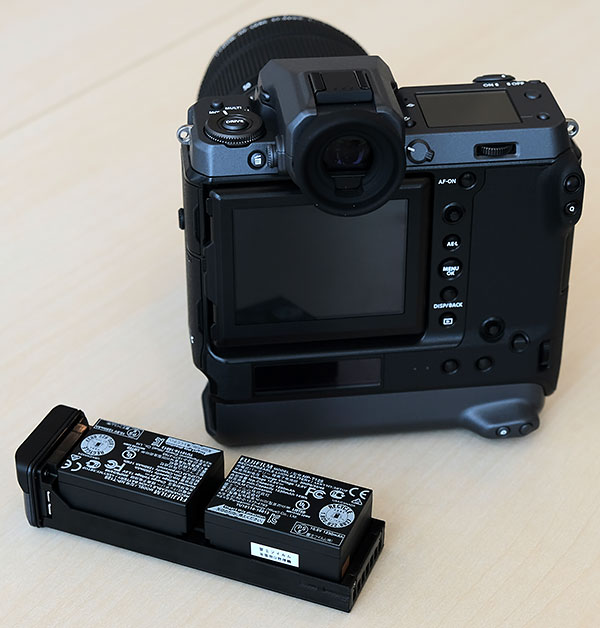
DE: Ah, so the structure, the way the phase-detect pixels are arranged in groups of five and then you have lines or groups within each of the five, like you did in the X-T3?
WB: And this is the first GF with phase-detect, right?
TI: Yes.
WB: Cool.
TI: So in terms of the sensor technology, it is a huge jump from 50 megapixels. It's not just, you know,doubling the [number] of the pixels...
DE: Right.
TI: It's also everything, the copper process, the backside-illumination, phase-detection.
DE: Mmm-hmm. Wow, and that's a big BSI sensor. I'm not sure I've heard of one that large before that's BSI. Wow... [Ed. Note: Phase One Industrial's iXM 100MP drone camera apparently also has a BSI medium format sensor.]
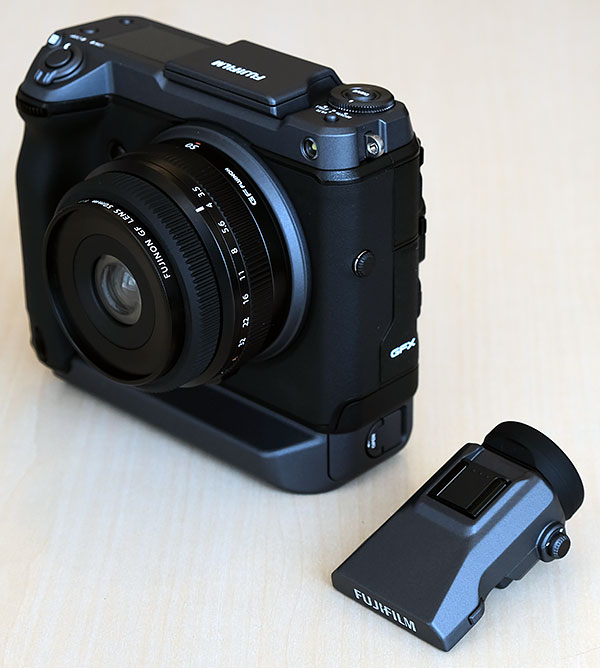
MO: After the X-T3, we developed some more-improved autofocusing...
DE: Ah, so there's even more then, there are AF advancements that weren't in the X-T3?
TI: ...on the software side.
MO: The Fuji X-T30 already has it.
DE: Ah!
MO: And we have a planned update for the X-T3 as well.
TI: Yeah, especially for face-detection and eye-detection, yeah.
DE: For face detection, ah. So that's a difference not in hardware, but in the algorithms in the X-T3.
TI: Yes.
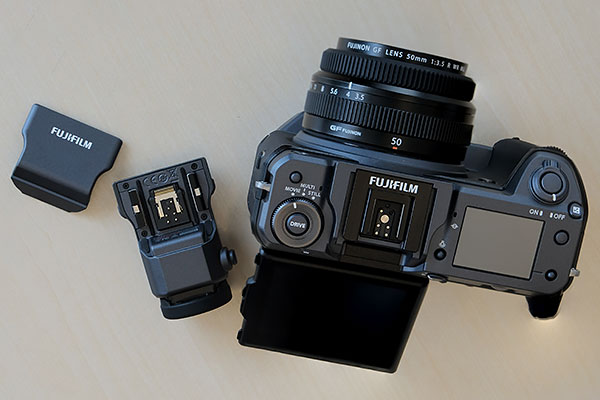
DE: That's one thing Fujifilm has always been good about, is supporting your existing models and continuing to update firmware. I think that's super-important, and I think it does a lot to make people loyal to your brand. I know that you may lose some sales in the short term because people may not upgrade as fast, but I think that it means much more commitment long-term, to stay with the platform.
Also talking about phase-detect, all of the mirrorless cameras except those from Olympus have linear phase-detect AF, but Olympus has cross-type. Is there a fundamental issue that prevents you from implementing cross-type? For instgance, are there blocking patents, or is it a technological issue on the sensor? I'm curious why is it only Olympus has done cross-type?
TI: So actually, the CMOS sensor is always reading by lines. So it isn't very suitable for horizontal phase-difference. [Ed. Note: That is, for PDAF pixels arranged vertically, so they're sensitive to detail that runs horizontally.] So yeah, of course technically we can make a cross-type system but normally, subjects are more...
DE: They're more vertical, yeah. There's are vertical subjects, so horizontally-arranged PDAF pixels support them better, yeah.
TI: So that's one of the main reasons.
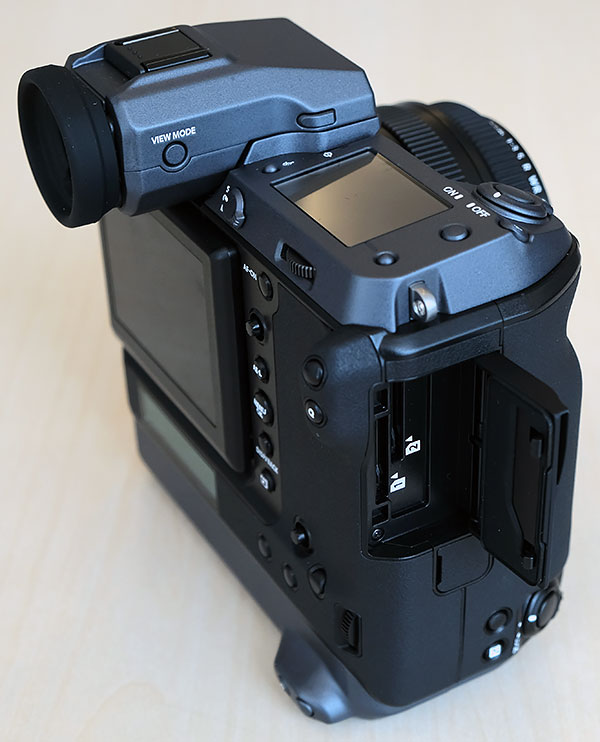
DE: Yeah, yeah. We haven't done a formal test of it, but we found a great deal of difference between products in terms of how much off-axis you have to be before the PDAF will detect horizontal lines. And to some extent, in speaking to Nikon, the argument for why they felt they didn't need the cross-type was that they had such a fine resolution horizontally. And in fact, it turns out that with the Z7, if I have a target with just horizontal lines, if I tilt it just a little bit, it catches it.
MO: Yeah, yeah.
DE: But by contrast, the EOS R, I have to tilt it like this. <gestures a larger angle> So it takes much more of an angle for the EOS R to focus on purely horizontal lines. But almost regardless of the camera, it's an issue that we've all encountered occasionally, where there's a subject -- maybe it's like trees in the distance when shooting in portrait mode or something -- there's some structure in the image that the camera doesn't want to focus on. So we would like to see cross-type AF points. But as you say, part of the fundamental issue is that the CMOS sensors are best suited to reading out entire lines. I guess maybe it depends, but anyhow, that's the answer, is that it's the structure of the sensor.
MO: Yeah, and also, so this is our sensor.
TI: This is our way, because our color filter is unique, the X-Trans structure...
MO: ZA/ZB is the phase-detect... [Ed. Note: As shown in the image above.]
DE: ...is phase-detection, yeah. But then, it only forms its baseline horizontally?
MO: When we analyze it, we can see not only horizontal difference but even the vertical difference.
DE: Oh, so you can do the correlation vertically as well? Ah, I hadn't realized that. So there's some amount of sensitivity in that direction as well.
MO: Yes.
DE: I think it might have been you that told me -- and this was the first that I had heard -- that when you read out the phase-data, you read the entire array phase-data and then you can look at that.
MO: Yes. And also with this sensor, we can read the signal and phase pixel separately. That's quite a bit better.
DE: Yeah. And that would let you read the phase signals quicker...
MO: Yeah. And also for instance, during movie recording, its exposure level is different for phase pixel and signal, right?
DE: Ah! So you can optimize the signal level for the phase-detect pixels without affecting the exposure of the image pixels?
TI: Yep.
DE: Ah.

TI: And also, the phase-detection sensor coverage is now 100%. So even places on the edge or corner will be detected quickly for autofocus.
DE: Yeah, yeah.
TI: Also the number of pixels is now over two million out of 26 million. The density is very high.
DE: Yeah, that's a lot. That's what, about 8% of all the pixels?
TI: Yeah, so that's also why it's good for low-light and high-frequency subjects like textures or something.
[Ed. Note: We've had to snip some crosstalk here as it was impossible to accurately transcribe. The upshot, though, was that the X-T3 has twice as many PDAF pixels as the X-T2 did, and processes them at twice as many spatial frequencies.]
DE: Right, more than four times.
TI: More than four times, so then the image processing is the challenge, because that's phase-detection processing...
DE: Yeah, you have a lot of data to deal with. And with phase-detection, it's like a large kernel [Ed. Note: Meaning chunks of pixels you have to process for each AF point.] You have to correlate across multiple baselines.
MO: Yes. Right. So this is our type of analysis, so this is the autofocus area <points to a diagram as shown below>. We used to have like 60 regions within each AF point, but now it's more, so four times bigger data...
TI: ...with more pixels.
DE: And that shows, of course, the phase-detect pixels arranged horizontally. But what you were saying is because you read all of that data off, if you wanted to you could do correlation vertically as well.
MO: Yep! So these six diferent frequencies means that sometimes, we compare the individual pixels for more higher-frequency texture. But sometimes for the low-light situation, we just combine them, it's good sensitivity, right?
DE: Mmm-hmm. So I know at low-light you sort of pixel-bin the rows, but is what you're saying that you also can pixel-bin horizontally for low-light as well?
MO: Yep, yep.
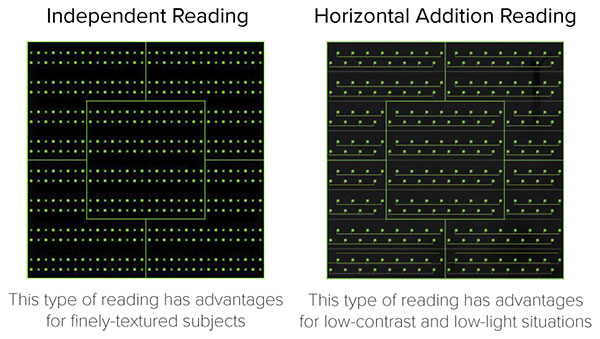
DE: So on each cycle, are you looking at six different frequencies, or are you just dropping frequencies?
MO: Yes, we can characterize simultaneously.
DE: Simultaneously for all frequencies, yeah. Because those are basically just different offsets and the math is done in the processing.
MO: That's why we need a new processor. <chuckles>
DE: Yes, yes. And it's significant to me that you could do the vertical correlation also, so that it may be a matter of just additional processing power, too. Your resolution is not quite as high vertically, maybe. Like from the pattern we discussed above, one set of ZA/ZB pairs are very close horizontally, but vertically there's always a separation.
MO: Yep.
DE: Ah. That's interesting. So then it's just that so far, you haven't felt a need to do vertical AF correlation.
MO: Nope.
DE: Hmm. That's very, very interesting to me!
[Ed. Note: This was all extremely interesting, albeit a little deep technically. Fujifilm has been doing a lot of work on their phase-detect autofocus (PDAF for short). The X-T2 was already pretty sophisticated in how the PDAF pixels were laid out and how they could be read out by the camera's processor. Now, the X-T3 has upped the ante by a significant amount.
As very basic background to the discussion above, PDAF works by looking at light coming from the two sides of the lens -- either horizontally or vertically -- and seeing how the light/dark patterns correlate with each other. That is, it takes a chunk of PDAF pixels that are looking at the left side of the lens and compares them with another chunk that's looking at the right side of the lens. If the subject is in focus, the images seen coming from the two sides of the lens will line up perfectly. If the subject is out of focus, though, you'd have to shift the two sets of pixels right or left relative to each other to get them to line up. (Wikipedia has further explanation in its autofocus article, from whence the image below hails.)
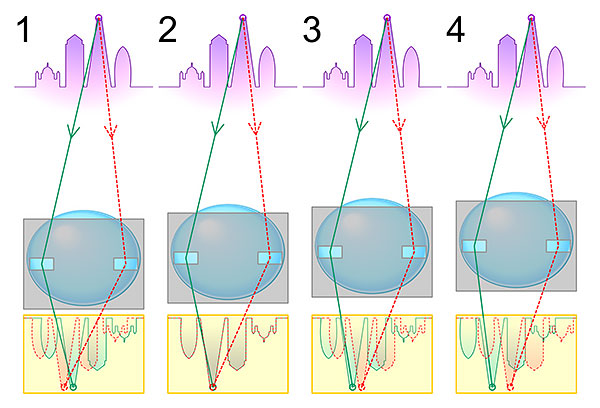
Image and caption courtesy of Cmglee / Wikimedia Commons, used under a CC BY-SA 3.0 license.
When you have a lot of PDAF pixels, these correlation calculations can take a lot of processor power. Additionally, Fuji also looks at PDAF pixels with different spacings, to be able to distinguish focus properly for both fine and coarse detail. They actually do the PDAF calculations for six different spatial frequencies, so the higher levels of their AF algorithms can get a better idea of what the subject looks like, and so can better determine the correct focal distance.
Finally, depending on the light level, the X-T3 can "bin" PDAF pixels together (basically just adding their contents) to get a better signal/noise ratio, and so be able to determine focus even in very dim lighting. Depending on how you do this, you'll trade off some ability to see the finest details, but it can really help in very low-light conditions.
Because PDAF works by shifting the images from the two sides of the lens back and forth relative to each other, it's naturally only sensitive to detail that's perpendicular to the direction you're shifting. So if you're looking at left-right shifts, you'll be able to pick up detail that runs vertically, but won't see detail that's arranged along the same direction. (For instance, most mirrorless cameras will refuse to focus on an image that has only horizontal lines in it.) PDAF points that are sensitive to detail in only one direction are called line-type, while AF points that can detect either vertical or horizontal detail are called cross-type. As far as I know, only Olympus has cross-type points on their image sensors; everyone else, incuding Fujifilm has line-type points.
In the interview, Oish-san said that if they wanted, they could do correlation vertically as well, and that would let them do cross-type AF detection. At the time, this made sense to me, but then I had to think about it a little, since the PDAF pixels themselves will be looking either left or right, not up or down.
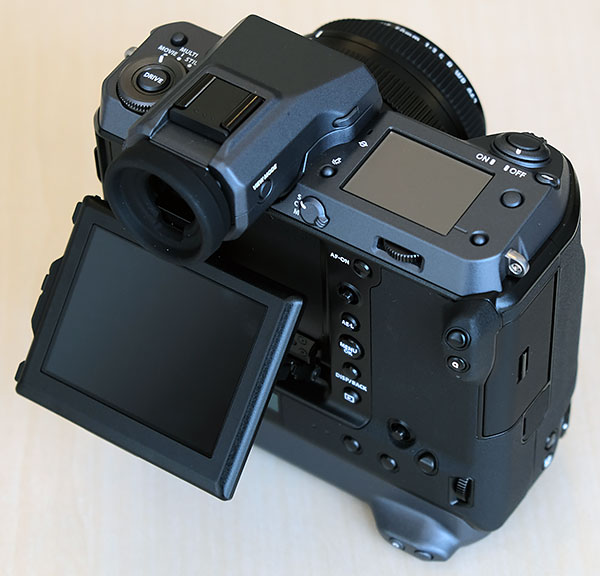
As I thought through it, though, I think it doesn't actually matter what direction the two sets of PDAF pixels are looking: The main thing is that the images from the two sides of the lens will be shifted with respect to each other, and you can just as well correlate along a vertical axis as a horizontal one; it's just that the sensor is read out by rows, so it might be slower to access the data for a vertical correlation.
I'm not at all sure of this, though; if anyone has a clearer understanding of what's involved, and whether you can do vertically oriented AF points with left/right-looking PDAF pixels (or not), please leave a note in the comments below.
Regardless of that particular point, from what they and others have shared with me, Fujifilm currently has the most sophisticated AF architecture of anyone in the mirrorless business.]
DE: And switching briefly to the GFX 100, what do you think the competing models are for that right now? Because there's nothing at that level that's right at the same price point with it. There are 100 megapixel cameras, but they're twice as expensive.
TI: Yeah, yeah. So probably almost zero competition. Because medium-format and 100-megapixel, 150-megapixel cameras are hugely expensive, hugely big. And full-frame is probably only at the moment maybe 50 megapixels for Canon, so I think, you know...
DE: I guess one difference with the traditional studio cameras, though, is that they typically have very, very high dynamic range. That's one characteristic where they'd win.
TI: Yeah, so 16-bit.
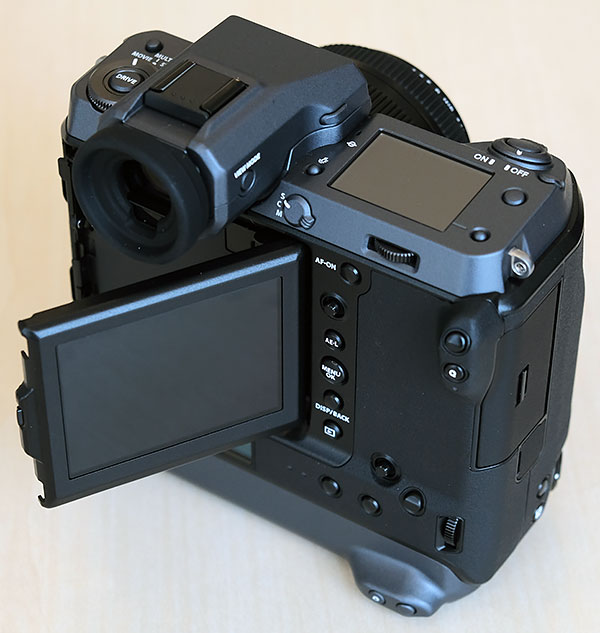
DE: Yeah. Do you think this will be able to steal market share from the studio camera applications?
TI: I think it depends on the studios' applications.
DE: Yeah, because you don't necessarily need 16-bit for every subject.
WB: Will the 100 megapixel do a multi-shot high-res shooting mode using the image stabilization system?
MO: We have the idea, but we didn't decide it.
WB: Oh, OK.
DE: Yeah, it must have been very tricky to make such a large IBIS mechanism. It's very large, and pretty high-mass, but also extremely high-resolution, so it requires both a powerful drive system and a lot of precision.
TI: Very... Yes, yes.
DE: Do you know yet how many stops of stabilization it is, how many EV?
MO: No, not...
DE: Not yet? Not characterized.
MO: Yeah not yet, but as much as possible.
<laughter>
DE: And my last question is just about the internal structure of Fujifilm. From our conversation, I know that you're simultaneously developing both the X and the GFX cameras. I'm curious how the teams are organized inside Fujifilm. Is there a lot of interaction between engineers on the teams?
TI: Of course, of course.
DE: Yeah?
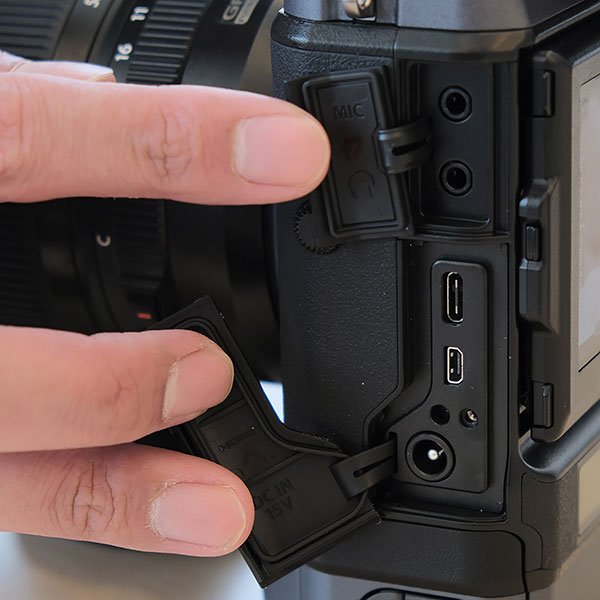
TI: Yes. I think, you know, we don't separate the team, so the same team works on both.
DE: So it's like, you have autofocus people and they're working on both products, and you have mechanical people...
TI: Yes. Yes, all platforms.
DE: Yeah. Ah, ah. And, and so then there's really no separation in R&D budget for X versus GFX.
TI: No, just one budget, as well.
DE: Yeah, you can decide where you want to spend the effort. Yeah. Hmm.
TI: Yes, the software, hardware and the, the lens, the design team they're also one team, and they would decide how much for GF, how much for X. So it's a bit flexible.
DE: Yeah, yeah.
TI: So we keep hearing the customer feedback, then we decide. This year, maybe more GF lenses; next year, maybe more XF lenses. That type of thing.
DE: Mmm-hmm, it goes back and forth depending on what you need on the different platforms.
TI: Yeah, we can be flexible.
DE: I'm curious: The GF lenses are much bigger physically. That doesn't affect the design effort, or maybe they have to have a higher standard in terms of what they're required to do. Is it more difficult to design the GF lenses?
TI: Of course, XF is also a different type of challenge, making them small and more compact.
DE: Ah, so it doesn't really take more effort one side or the other?
MO: Actually, like for example chromatic aberration, because the image sizw is bigger, four times larger, right, there should be four times bigger aberration. So we minimize it.
DE: So that is a harder issue.
MO: So we have to make it one-fourth smaller chromatic aberrations than the XF lens. <chuckles>
DE: Mmm. Yeah, yeah.
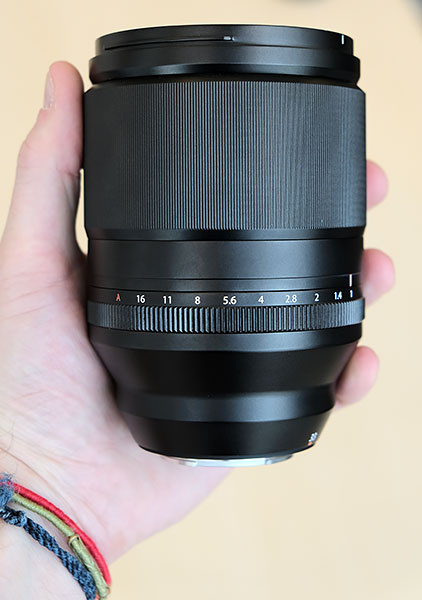
TI: Yeah, but on the other hand, this lens <gesturing at a mockup of an XF33mmF1 lens>, like a 33mm f/1.0 design, that's a totally different type of challenge for the lens designers...
WB: That's a mockup?
TI: It's a mockup, yeah.
WB: Wow.
DE: 33mm, f/1.0. Wow!
TI: So 50mm-equivalent.
DE: Yeah, that's...
WB: That's a lot of glass in there.
DE: That's got to be a lot of design to make that. I remember several years ago you describing how you design the lenses, and that you really trying to optimize across the frame.
TI: Yes.
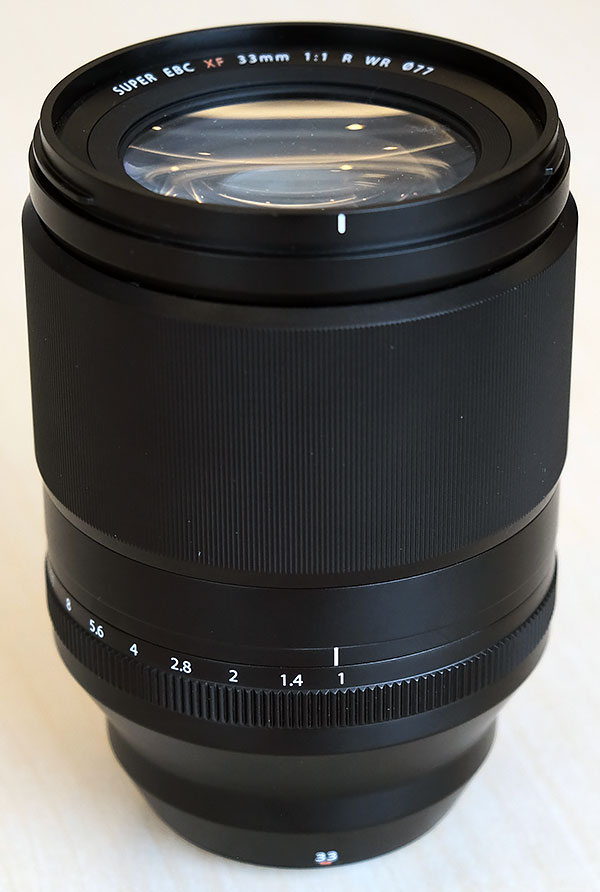
DE: Also, one of the engineers explained to me that in a typical lens, as you move from out of focus in one direction through focus and then back out of focus in the other direction, the image only gets sharper to a certain level, and then the sharpness doesn't change over a small range of focal settings, before getting worse again. But Fujifilm designs the lenses so that there's a single point of optimal focus, and that point is sharper than would be the case in designs that had a broad focus peak.
TI: Because of mirrorless. Right.
DE: Ah, with DSLRs that have separate AF sensors, you may need that little bit of the focus not changing, to allow for slight innacuracies in the focus setting.
TI: The whole word autofocusing means to be more sharp.
DE: Oh, also, relating to lenses and the GF... With the GFX 100 coming, I guess the lenses already have to be fast for contrast-detect, so phase-detect if anything relaxes the requirement actuator speed a little, so it's getting easier rather than harder.
TI: Yes.
DE: It would have been harder if you had had phase-detect, and then you had to make them work for contrast.
Well we're about out of time, and I think that's actually all of my questions. Thanks as always for your time!
TI: Yes, thank you.
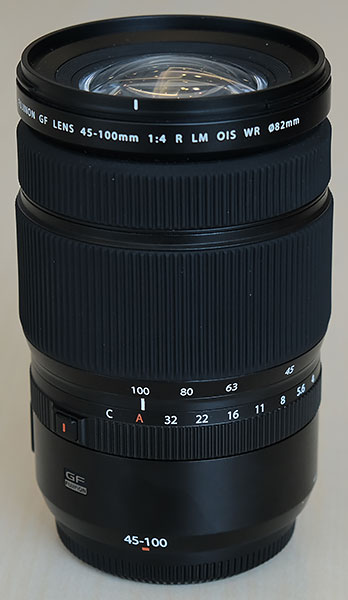
Summary
This was a great interview, as always with Iida-san and Oishi-san. I've actually been wanting to write about Fujifilm's on-sensor PDAF technology for a while now, as I think their technology is arguably the most advanced on the market, when it comes to both their on-chip architecture and the processing they do to make use of the raw data. It's of course possible that other manufacturers use similar approaches, but if they in fact had as- or more-advanced AF architectures, I would think they'd have been touting them, as Fuji has. It's also clear that Fujifilm has made significant strides in this area, as evidenced by the stats they cite for improved performance between their current- and prior-generation AF technology. In the lens area, we saw mockups of a couple of very interesting models, including a crazy wide-aperture 33mm f/1.0 that'll be a super-fast "normal" lens for their APS-C cameras. Finally, their coming 100-megapixel GFX 100 body seems poised to shake up the medium-format arena once again, competing with dramatically more expensive products from other manufacturers. I've often observed that this is a great time in history to be a photographer; it looks like it's a particularly great time to be a Fujifilm one :-)